A. Volume of Fisheries Production
From 2020 to 2024, the fisheries production in Davao Region displayed a notable upward trajectory, although with fluctuations in the latter years.
Starting at 45,556.23 metric tons in 2020, production increased steadily to 48,630.40 metric tons in 2021. The most significant growth occurred in 2022, when the region recorded an impressive 81,322.31 metric tons of production — a surge of over 67.0 percent from the previous year. This peak marked a substantial boost in the region’s fisheries output. However, after reaching this high point, production declined in 2023 to 75,958.84 metric tons and further decreased to 63,979.72 metric tons in 2024 (Figure 1).
Despite the downturn, the region’s 2024 output remained considerably higher than its 2020 level, indicating overall growth over the five-year period.
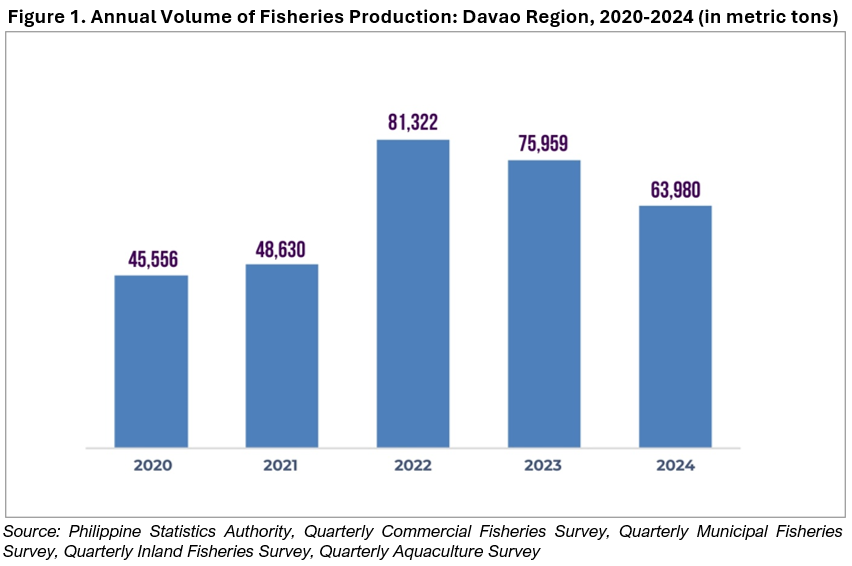
A closer look at the provinces reveals that Davao Oriental played a pivotal role in the 2022 peak, with its production surging from just 7,947.62 metric tons in 2021 to 30,300.39 in 2022—nearly quadrupling its output. This province maintained relatively high output in 2023 and 2024, though it slightly declined to 23,434.69 metric tons by the end of the period. Davao del Sur also contributed significantly to the overall growth, climbing from 12,920.08 metric tons in 2020 to 24,758.62 in 2023, before tapering slightly in 2024. Meanwhile, Davao Occidental had consistent growth from 2020 to 2022 but saw a sharp drop by 2024, cutting its peak output nearly in half (Table 1).
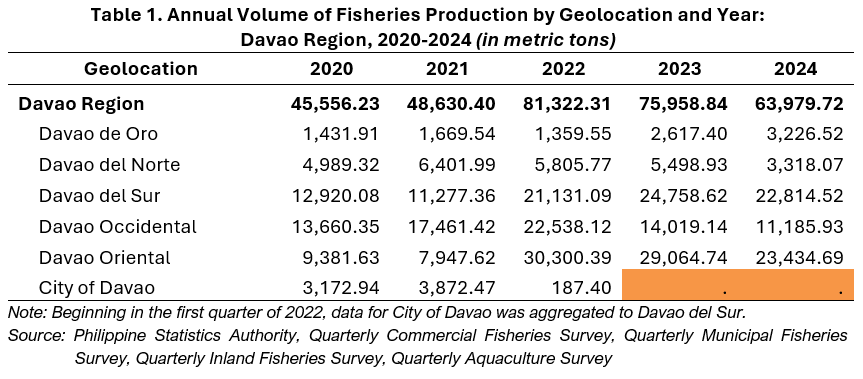
Davao de Oro showed gradual but steady growth, particularly from 2022 to 2024, with its production more than doubling—from 1,359.55 to 3,226.52 metric tons. Davao del Norte, in contrast, experienced a consistent decline after 2021.
B. Volume of Commercial Fisheries Production
The commercial fisheries subsector in Davao Region demonstrated a consistently strong growth pattern over the five-year period from 2020 to 2024.
Beginning at 1,652.47 metric tons in 2020, production rose to 2,209.79 metric tons in 2021, marking a 33.7 percent increase. This moderate growth was followed by a surge in 2022, when production climbed to 5,673.52 metric tons—a 156.8 percent increase from the previous year.
Growth continued in 2023, although at a slower pace, with production rising to 6,238.71 metric tons, representing a 9.9 percent increase from 2022. In 2024, the upward trend continued as output reached 6,664.07 metric tons, a 6.8 percent increase from the previous year.
Overall, from 2020 to 2024, commercial fisheries production in the Davao Region grew by a remarkable 303.3 percent—quadrupling its original volume in just five years (Figure 2).

While commercial fisheries production in Davao Region expanded significantly, growth was not uniformly distributed across the region. It was largely driven by the sustained rise of commercial fisheries in Davao Oriental. Davao Oriental's production surged from 983.07 metric tons in 2020 to 6,180.71 metric tons in 2024, a remarkable increase of 528.7 percent. The province accounted for nearly 93 percent of the region's total commercial fisheries output in 2024. Year-on-year, it posted substantial growth: 25.5 percent in 2021, 249.5 percent in 2022, followed by further gains of 15.3 percent in 2023 and 24.2 percent in 2024 (Table 2).
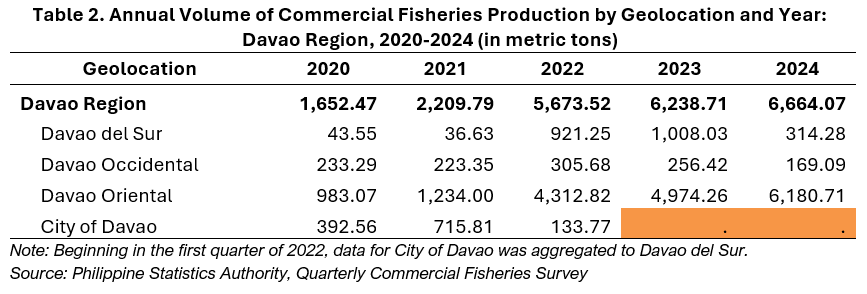
In contrast, Davao del Sur experienced a dramatic but short-lived spike. After modest figures in 2020 and 2021, its output jumped from just 36.63 metric tons in 2021 to 921.25 metric tons in 2022. This surge continued into 2023, peaking at 1,008.03 metric tons. However, by 2024, production sharply declined to 314.28 metric tons, representing a 68.8 percent drop.
Davao Occidental, meanwhile, maintained moderate production early on, but saw a downward trend after 2022. From 305.68 metric tons that year, output dropped to 256.42 in 2023 and further to 169.09 in 2024, pointing to a gradual contraction in commercial fishing activities.
C. Volume of Marine Municipal Fisheries Production
The municipal fisheries production in the region exhibited significant shifts, marked by a dramatic mid-period surge followed by a noticeable decline.
In 2020, production stood at 17,977.65 metric tons and slightly decreased in 2021 to 17,607.25 metric tons, a marginal drop of 2.1 percent. However, in 2022, the sector experienced a remarkable leap, with production climbing to 43,327.69 metric tons — a 146.1 percent increase from the previous year (Figure 3).
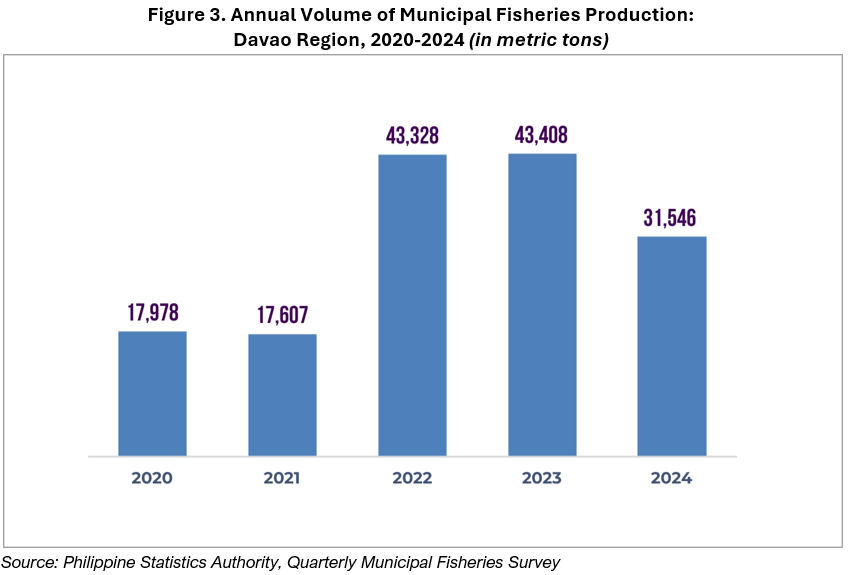
This elevated level of production was sustained into 2023, with a slight increase to 43,408.33 metric tons, suggesting stability in the sector after the 2022 surge. However, by 2024, municipal fisheries’ production dropped significantly to 31,545.51 metric tons, marking a 27.3 percent decrease from the previous year.
Across the region, Davao Oriental was the standout contributor to the regional surge in municipal fisheries. Its municipal fisheries production jumped from 5,374.93 metric tons in 2021 to 25,397.47 in 2022—a 372.4 percent increase. Though production slightly declined to 23,577.24 in 2023 and further to 16,866.56 in 2024, the province consistently led in output throughout the peak years. Davao Occidental also played a key role, increasing from 6,505.36 metric tons in 2020 to 13,089.12 in 2022 before declining to 7,740.72 in 2024. Davao del Sur followed a similar trend, more than doubling its output between 2021 and 2023, from 2,057.88 to 5,050.07 metric tons, then dropping to 4,127.23 in 2024 (Table 3).
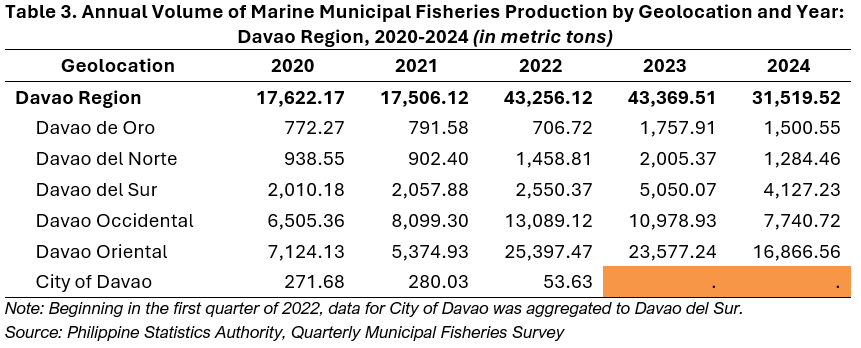
Meanwhile, Davao del Norte and Davao de Oro showed modest contributions. Davao del Norte increased its production gradually from 902.40 metric tons in 2021 to 2,005.37 in 2023 before declining to 1,284.46 in 2024. Davao de Oro experienced a similar trajectory, peaking at 1,757.91 in 2023 and dipping to 1,500.55 in 2024. The City of Davao, on the other hand, saw its production drop sharply from 280.03 in 2021 to just 53.63 in 2022.
Altogether, the surge in municipal fisheries production during 2022 and 2023 was primarily driven by Davao Oriental, supported by notable growth in Davao Occidental and Davao del Sur. However, the decline in 2024, particularly from these leading contributors, brought regional production down from its peak.
D. Volume of Inland Fisheries Production
The inland municipal fisheries production in the region reflects a clear and continuous downward trend, marking it as the most consistently declining subsector in the region's fisheries industry.
In 2020, production stood at 355.48 metric tons, but this figure dropped sharply to 101.13 metric tons in 2021, a steep 71.6% decrease. The decline continued in 2022 with production falling to 71.57 metric tons, then to 38.82 in 2023, and finally to just 25.99 metric tons in 2024.
Over the five-year period, this represents an overall decline of 92.7 percent (Figure 4).
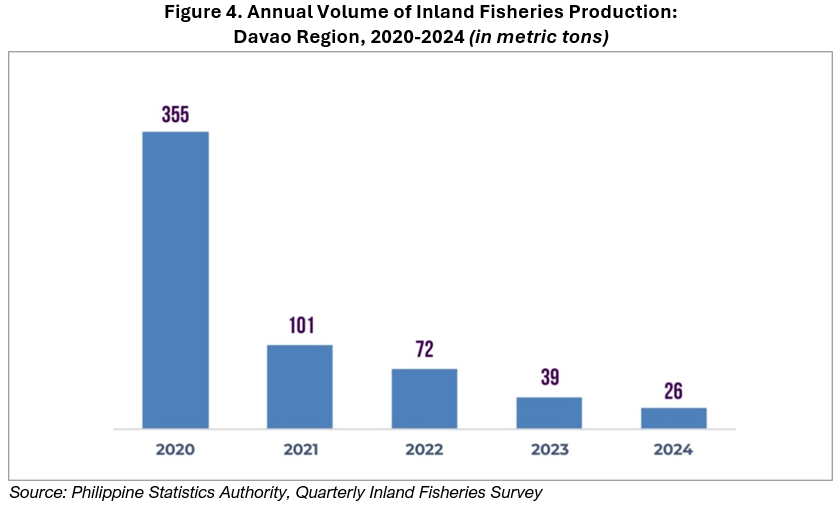
Analyzing the inland municipal fisheries production of the region by province or city underscores a consistent and widespread decline across nearly all geolocations (Table 4).
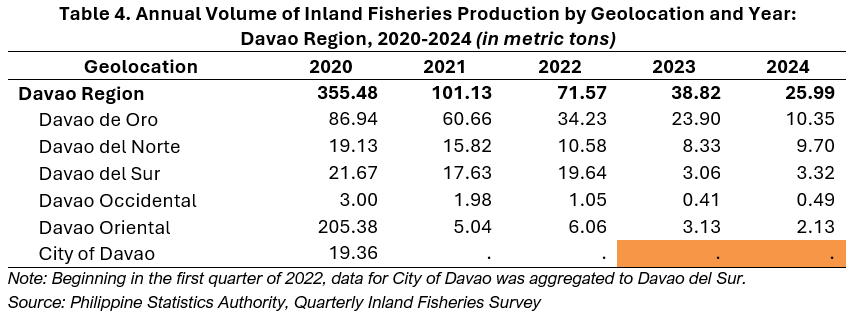
In 2020, the region recorded a total of 355.48 metric tons of inland fisheries output. The largest contributor that year was Davao Oriental, producing 205.38 metric tons, or about 58.0 percent of the regional total. However, Davao Oriental’s inland fisheries declined to just 5.04 metric tons in 2021 — a 97.5 percent drop — and continue to decline to 2.13 metric tons by 2024. This sharp decline has likely driven much of the region’s overall decrease in output.
Davao de Oro, initially the second-largest contributor at 86.94 metric tons in 2020, experienced a steady but less abrupt decline, reaching 10.35 metric tons in 2024, a 88.1 percent reduction over five years. Similarly, Davao del Sur dropped from 21.67 metric tons in 2020 to just 3.32 metric tons in 2024, with the steepest fall occurring between 2022 and 2023.
Davao del Norte, though a smaller contributor, saw fluctuations — starting at 19.13 metric tons in 2020, slightly decreasing in the next two years, but increasing to 9.70 metric tons in 2024 after a dip in 2023. Despite the bump, the province still posted a 49.3 percent decline from its 2020 level.
Davao Occidental consistently reported the lowest inland fisheries output, starting from 3.00 metric tons in 2020 and dropping to less than 0.5 metric tons by 2024, an 83.7 percent decrease.
E. Volume of Aquaculture Production
The aquaculture fisheries production in Davao Region from 2020 to 2024 followed a pattern of early growth followed by a notable decline.
In 2020, aquaculture production stood at 25,926.11 metric tons. It grew steadily over the next two years, reaching 28,813.36 metric tons in 2021, an increase of 11.1 percent, and then peaking at 32,321.10 metric tons in 2022, reflecting a total growth of 24.7 percent from 2020 (Figure 5).
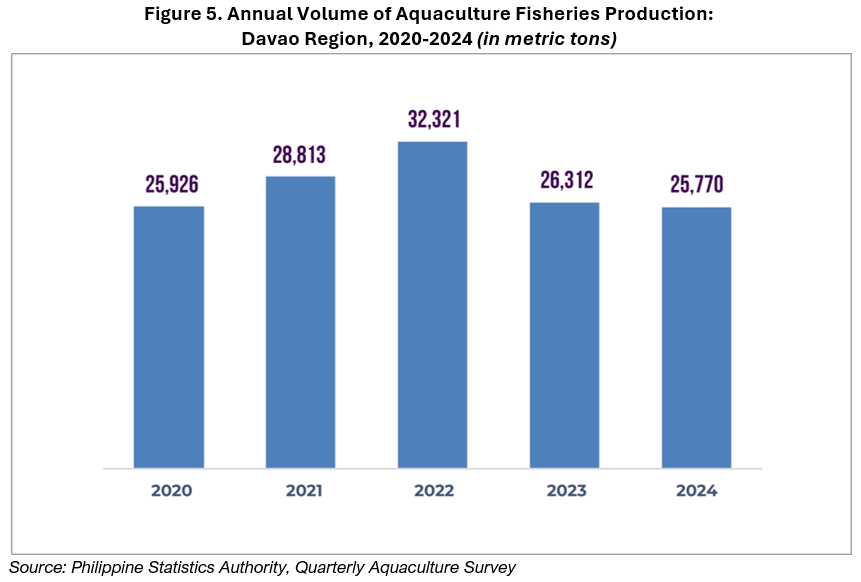
However, starting in 2023, production saw a significant reversal. Output dropped to 26,311.80 metric tons, an 18.6 percent decline from the previous year. The downward trend continued into 2024, with production falling slightly further to 25,770.14 metric tons.
Despite the decline in the latter years, aquaculture remained one of the largest contributors to Davao Region’s fisheries production throughout the five-year period.
When analyzed by geolocation, the aquaculture fisheries production reveals an interesting shift in provincial contributions that shaped the overall regional trend of early growth followed by decline.
While the region as a whole saw production rise from 25,926.11 metric tons in 2020 to a peak of 32,321.10 in 2022, it later fell to 25,770.14 by 2024, almost back to its starting point. This fluctuation was largely influenced by changes in outputs from key provinces — particularly Davao del Sur, Davao Occidental, and Davao del Norte (Table 5).
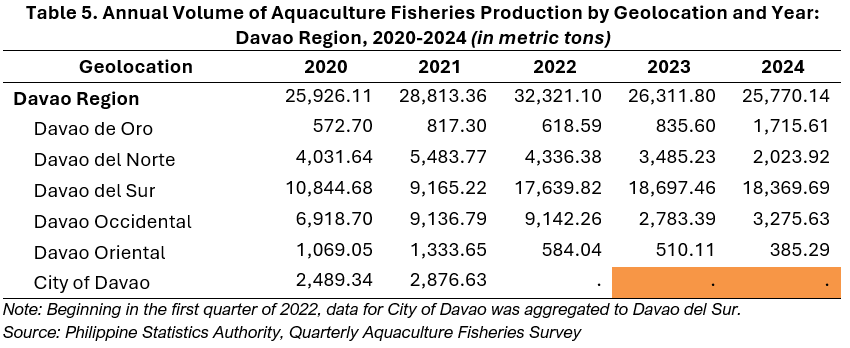
Davao del Sur consistently led the region in aquaculture production. It began with 10,844.68 metric tons in 2020, decreased slightly in 2021, and then surged to 17,639.82 in 2022 and 18,697.46 in 2023, before dipping slightly to 18,369.69 in 2024. Despite the minor decline in the final year, the province’s contribution remained strong and stable, making it the backbone of the region’s aquaculture sector.
Davao Occidental, which posted a steady production of approximately 9,100 metric tons in 2021 and 2022, experienced a dramatic drop in 2023 to 2,783.39, although it recovered slightly in 2024 with 3,275.63. This sharp decline significantly impacted the region’s total output between 2022 and 2023.
Davao del Norte also saw a steady decline after 2021. From 5,483.77 metric tons in 2021, its production fell to 2,023.92 in 2024, a drop of over 63.0 percent in three years. This persistent downward trend further contributed to the regional decrease in total aquaculture volume.
In contrast, Davao de Oro stood out as a growing contributor. While its production was relatively low in the early years — 572.70 in 2020 — it nearly tripled to 1,715.61 metric tons by 2024. Though still small in scale compared to Davao del Sur, its upward trend countered the broader regional decline to some extent.
Davao Oriental, however, experienced a continuous drop across all five years, starting from 1,069.05 metric tons in 2020 and ending with only 385.29 in 2024 — a 63.9 percent decrease.
The peak in Davao Region's aquaculture production in 2022 was largely fueled by the strong performances of Davao del Sur and Davao Occidental. However, the subsequent decline was triggered by steep drops in these same areas — particularly Davao Occidental — as well as persistent decreases in Davao del Norte and Davao Oriental.
F. Top 10 Species by Volume of Production
From 2020 to 2024, the top species by volume of production in Davao Region were consistently led by milkfish, followed by marine species such as big-eyed scad, squid, and yellowfin tuna, alongside Penaeus vannamei (whiteleg shrimp) and seaweed.
Milkfish dominated production every year, peaking at 25,172 metric tons in 2022, before slightly declining to 19,239 in 2024. Squid showed a notable rise, from 1,477 metric tons in 2020 to a peak of 8,509 in 2023, then settled at 7,116 in 2024. Big-eyed scad (matangbaka) also increased sharply, reaching 10,952 metric tons in 2023, before dropping to 4,837 in 2024 (Figure 6).
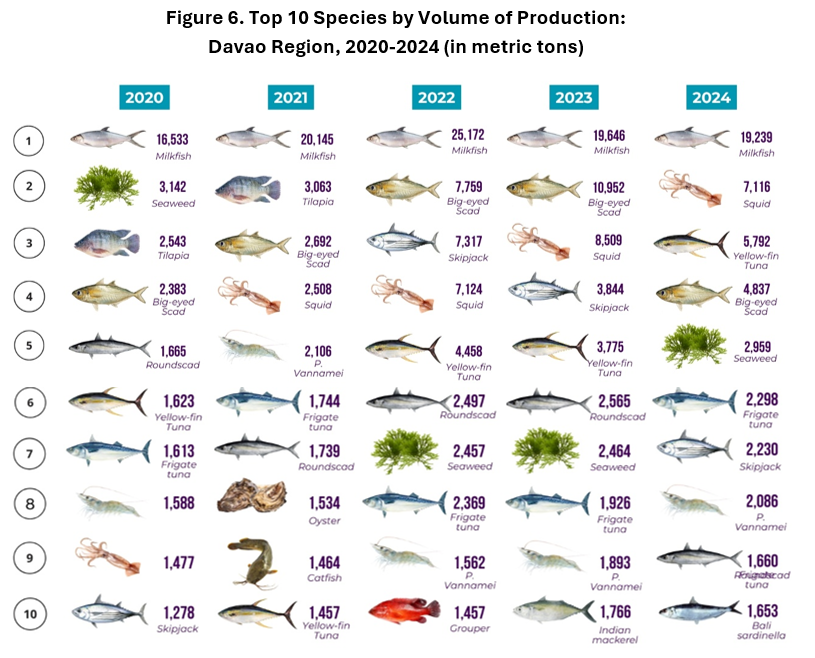
Yellowfin tuna showed consistent production growth, climbing from 1,623 metric tons in 2020 to 5,792 in 2024, while P. vannamei shrimp maintained a stable presence, with annual outputs ranging between 1,562 and 2,106 metric tons. Seaweed, after a sharp drop in 2021, rebounded steadily and reached 2,959 metric tons in 2024.
Other frequently appearing species in the top 10 included frigate tuna (tulingan), skipjack (gulyasan), roundscad (galunggong), and newcomers like Bali sardinella (tamban) and Indian mackerel (alumahan) in the later years.
APPROVED FOR RELEASE:
RANDOLPH ANTHONY B. GALES
(Chief Statistical Specialist)
Officer-In-Charge
Regional Statistical Services Office 11
